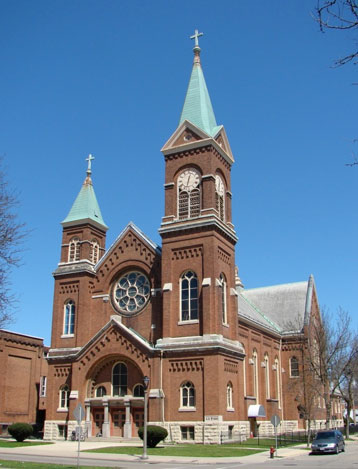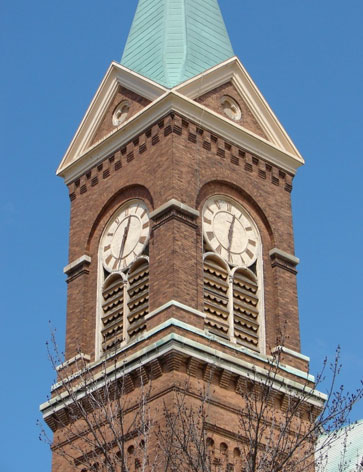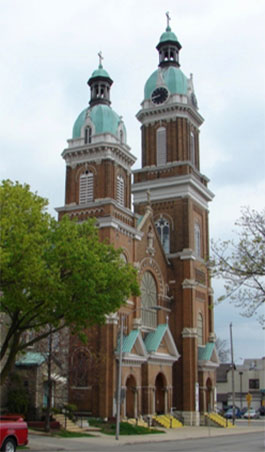18. St. Lawrence Catholic, 1905
1418 South Layton Boulevard (at Orchard Street)
Architects: Erhard Brielmaier and Sons
In 1888, the Catholic Archdiocese of Milwaukee established St. Lawrence Parish in response to the need for a German-language parish in what was then the westernmost neighborhood on the South Side. Layton Boulevard (then 22nd Avenue) was the western city limit at that time. The two earlier German Catholic churches on the South Side, Holy Trinity and St. Anthony’s, are 33 and 21 blocks away, respectively.
The first church for St. Lawrence Parish was a small wooden building, originally built as a school, which was moved from St. Joseph’s Convent across the street. This was replaced by the end of 1888 with a larger church that served the parish until it was severely damaged by fire in October of 1904. The parish then commissioned the firm of Erhard Brielmaier and Sons to prepare plans for the present church. Construction began in 1905, with the building completed in August of the following year.
The Brielmaier firm designed a large Romanesque Revival church with seating for 1,000 worshipers. The southwest tower and steeple reach a height of more than 160 feet from the ground to the top of the cross. St. Hedwig’s Catholic is the only other Romanesque Revival church in the city with a steeple of comparable height. Above the front entrance is a broad arch, 24 feet in diameter, which spans all three doorways. Arches of this scale are more common to Richardsonian Romanesque buildings, as on the façade of Grand Avenue Congregational, for example. However, St. Lawrence Church has no other distinctly Richardsonian features.
While the details of the church are characteristic of the Romanesque Revival, the building’s overall form is quite similar to some of the city’s two-tower churches in other styles. In fact, St. Lawrence bears a strong resemblance to the nearby St. Vincent de Paul Catholic at 21st and Mitchell Streets, designed by Bernard Kolpacki and built just five years earlier. The two churches are of similar size and constructed of brown brick, with a taller tower on the right side of the façade and a shorter tower on the left. St. Vincent de Paul is clothed in classical rather than Romanesque details, including pediments above each of the three front entrances and domes rather than steeples topping the towers. The comparison illustrates how architectural style terms are often based on a building’s ornamentation and details rather than its form.
St. Lawrence parish had a clock installed in the southwest tower of the church in 1988, as part of renovations undertaken for its centennial. The clock faces date to the original construction of the church, but there were no working hands or chimes until 1988. Also in the late 1980s, the bells were restored to working condition. The church’s three bells were installed in 1912 but had been inoperable for many years. The three bells range in size from 1,600 to 2,800 pounds.
St. Lawrence parish merged with the nearby St. Matthew’s Parish around the turn of the present century, with the combined parish adopting the name Prince of Peace. Services are now held at the former St. Matthew’s Church just four blocks away. Within a few years of the merger, St. Lawrence Church was being used by Grace Hmong Alliance Church and the adjacent parish school became the Hmong American Peace Academy, a charter school for the children of Hmong immigrants. More than 150,000 Hmong refugees came to the United States from Laos and Vietnam between 1979 and 1996. Wisconsin was the third largest recipient state, after California and Minnesota. By 1999, there were 15,000 Hmong immigrants in Milwaukee, with the largest portion of these initially settling on the South Side in the vicinity of Layton Boulevard. Both Grace Hmong Alliance Church and the Hmong American Peace Academy have more recently moved to a new location in the northwestern part of the city.
Sources:
Brielmaier, Erhard & Sons, architects. Drawings for construction of St. Lawrence Catholic Church, undated. Wisconsin Architectural Archive, Milwaukee Central Library, drawing set 31-0018.
Fungchatou, Lo. The Promised Land: Socioeconomic Adjustment of the Hmong in Milwaukee, 1976-2000. Ph. D. dissertation, University of Wisconsin – Milwaukee, 2000.
Historic Designation Study Report: Layton Boulevard Historic District. City of Milwaukee, Department of City Development, 2004.
“Many Attend Dedication,” Milwaukee Sentinel, August 13, 1906, page 4, column 3.
St. Lawrence: 75th Anniversary, 1888-1963. St. Lawrence Parish, 1963.
St. Lawrence. 100 Years: Community – Church – Christ. St. Lawrence Parish, 1988.



